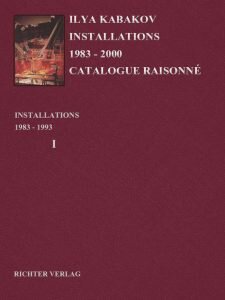The Ship
YEAR: 1985
CATALOGUE NUMBER: 10
PROVENANCE
The artist
First realized 1985 in the Moscow studio
Collection Musée d’Art Contemporain, Lyon, since 1987.
EXHIBITIONS
Das Schiff – Die Kommunalwohnung, zwei Installationen von Ilya Kabakov, Kunsthalle Zürich, Zurich, 2 June – 30 July 1989.
Histoires de sculpture, Espace Lyonnais d’Art Contemporain, Lyon, 12 October – 19 November 1989.
Das Schiff, Neue Galerie, Sammlung Ludwig, Aachen, 30 September – 4 November 1990.
Rencontres, Le Magasin, Centre National d’Art Contemporain, Grenoble, 21 February – 29 April 1993.
DESCRIPTION
The installation is a rather large construction, 25 meters in length and 10 meters in width. Its layout actually resembles a ship: it has a ‘bow,’ a ‘captain’s deck cabin’ raising high above the floor, two ship sides surrounding the entire construction, and a large central part consisting of five eight-meter wooden stands with wallpaper strips glued to them. All the structures are made of wood, and the expositions are paper, cardboard, photo documents, books, magazines, etc. In this sense, the overall appearance of the ‘ship’ resembles the propagandistic structures that were typical for Soviet Russia for the 1920’s-30’s, where the combination of the dynamic, pompous construction, the abundant photo material, and slogans all served to inspire one to move toward the bright Socialist tomorrow. Here is an enormous quantity of propagandistic visual agitation: postcards, posters, and the like. But the main cargo filling the entire structure is entirely different. It consists of genuine documents – letters, requests, and complaints of residents of communal apartments about the daily torment of communal living in unbearable conditions – approximately two thousand documents revealing the everyday gulag that existed in Moscow as well as in any other one of our cities. These letters are glued one after another on long pieces of wallpaper and attached to wooden lines in five rows so that the viewer moves through corridors of anguish like between library display cases.
CONCEPT OF THE INSTALLATION
Beginning from the time of the Revolution, it was believed that every government establishment or factory should have its own club. These clubs were built not only so that the workers could spend time there, relax, but also so that they could receive the necessary political education. The first post-revolutionary clubs were places where the Bolsheviks ‘enlightened’ the dark masses with the light of their ideas, where they organized lectures about their projects and plans, about the bright future waiting for everyone under the new government. Often hand-made slogans, posters, appeals were hung up to cover the walls of an old building or shack so as to remake it into such a club. Banners were hung up near the portraits of the leaders in the ‘red corner,’ benches were placed along the walls, brochures with the speeches of Lenin, Trotsky, and others were placed on hastily assembled tables.
Gradually these temporary clubs turned into permanent ‘chapels’ of the new religion. They became mandatory for each enterprise and wound up being subordinate to special ‘ideological’ departments of the Party Committee of the factory, collective farm, university. Gradually these clubs became more respectable, solid. Everything was decorated more and more splendidly, richer and richer. During the ‘30’s, ‘40’s, ‘50’s, this was a place for mandatory meetings for the entire collective (for Party members under the threat of being expelled from the Party), meetings with delegations, meetings between representatives of those in power and the people. Agitation and propaganda, even though it had lost its initial meaning (there was no one left to agitate and propagandize since the Bolsheviks had claimed complete victory), all of these ‘revolutionary’ attributes were preserved out of tradition, and they acquired a somewhat different appearance and significance. Now the entire layout of these clubs (they were sometimes called ‘red corners’) was reduced to the display of victories of the Socialist system ‘on all fronts’ in the USSR and in other (already after the war) countries of Socialism. Large structures were made in the constructivist style with enormous expenditures (money was disbursed for propaganda without counting). They consisted of combinations of photographs, slogans, documents, appeals, paintings. Entering such a place and passing by it from all sides, the visitor – according to the ideas of the workers of the ideological front – even though he knew everything already and rejoiced and admired it all, nonetheless, upon seeing this ‘aggregate of happiness,’ he would receive a new dose of optimism and confidence, since the entire cosmos of victories and the prosperity of his beloved Motherland were reflected in each photograph and painting, like in a little drop.
But in the 1960’s-70’s, life in the club-temples gradually began to be extinguished. The cult departed more and more despondently and mechanically. The propagandistic structures, stands and posters gradually began to decay (even though on the streets they were still erected out of steel and cement). And all of it together – the ritual, the design, and the paint – turned into some depressing, useless ceremony, supported with difficulty by the ideological departments and hired artist-professionals who drew joyful faces in the old cliché ways against the background of the blue sky.
Images
Literature







